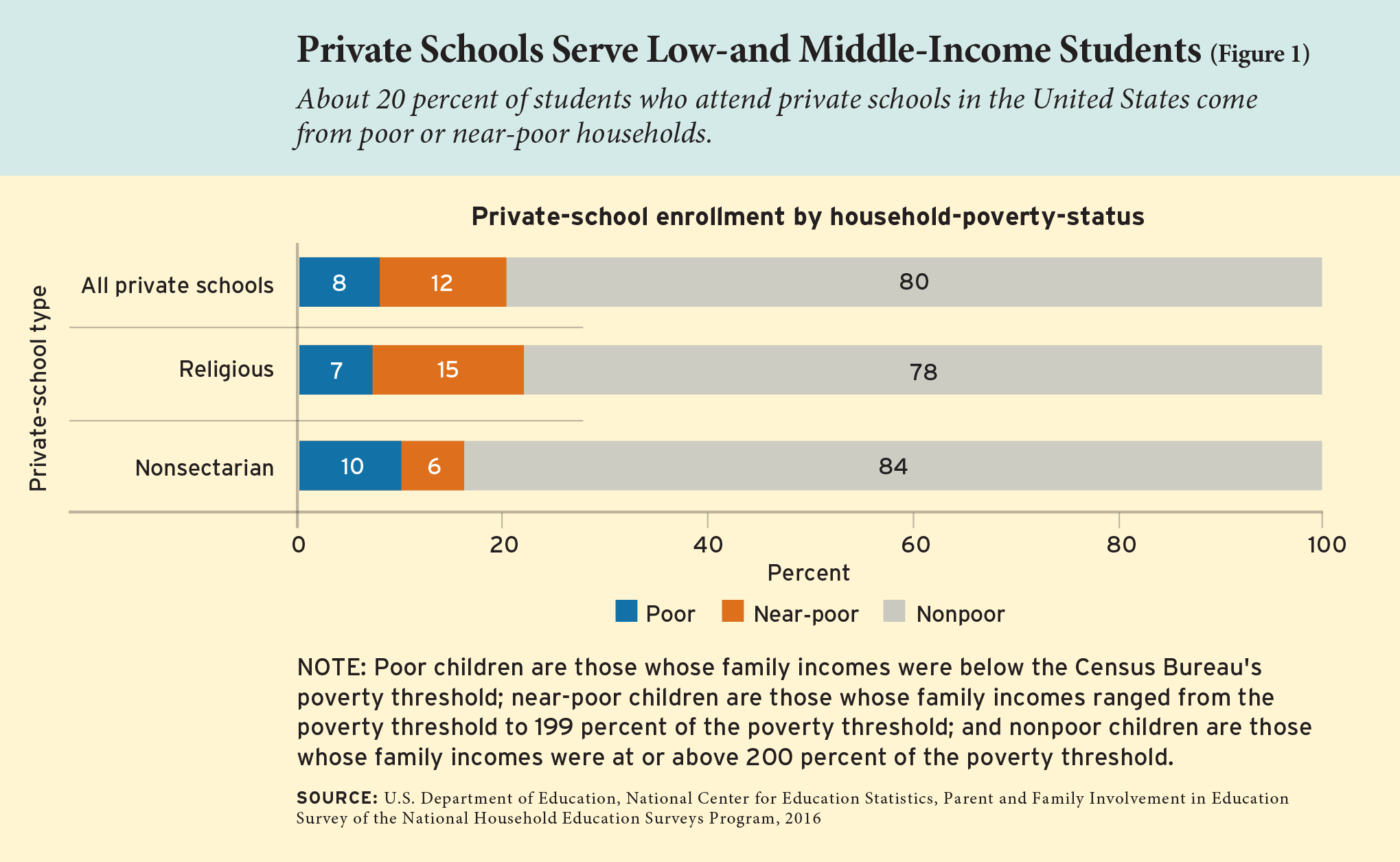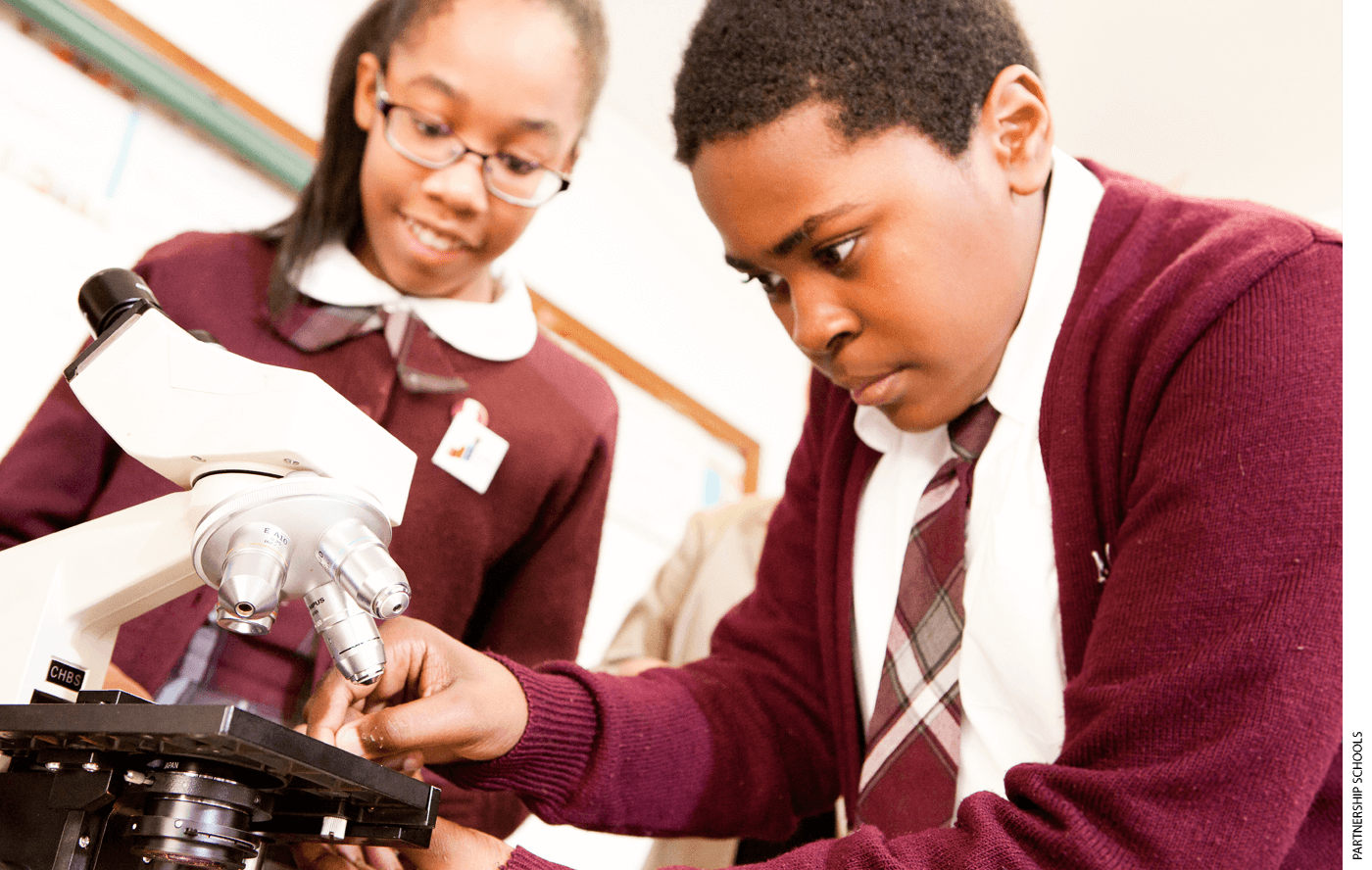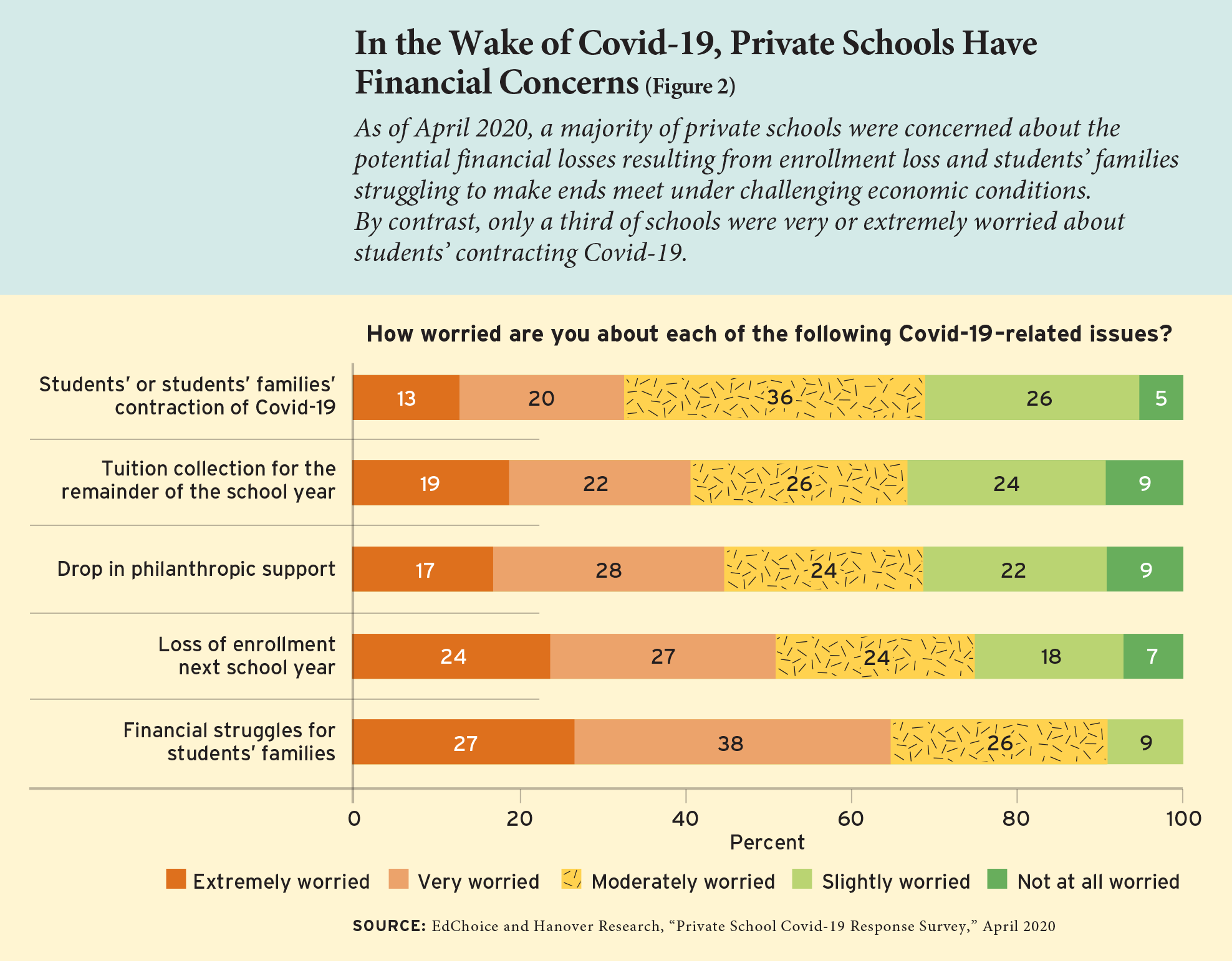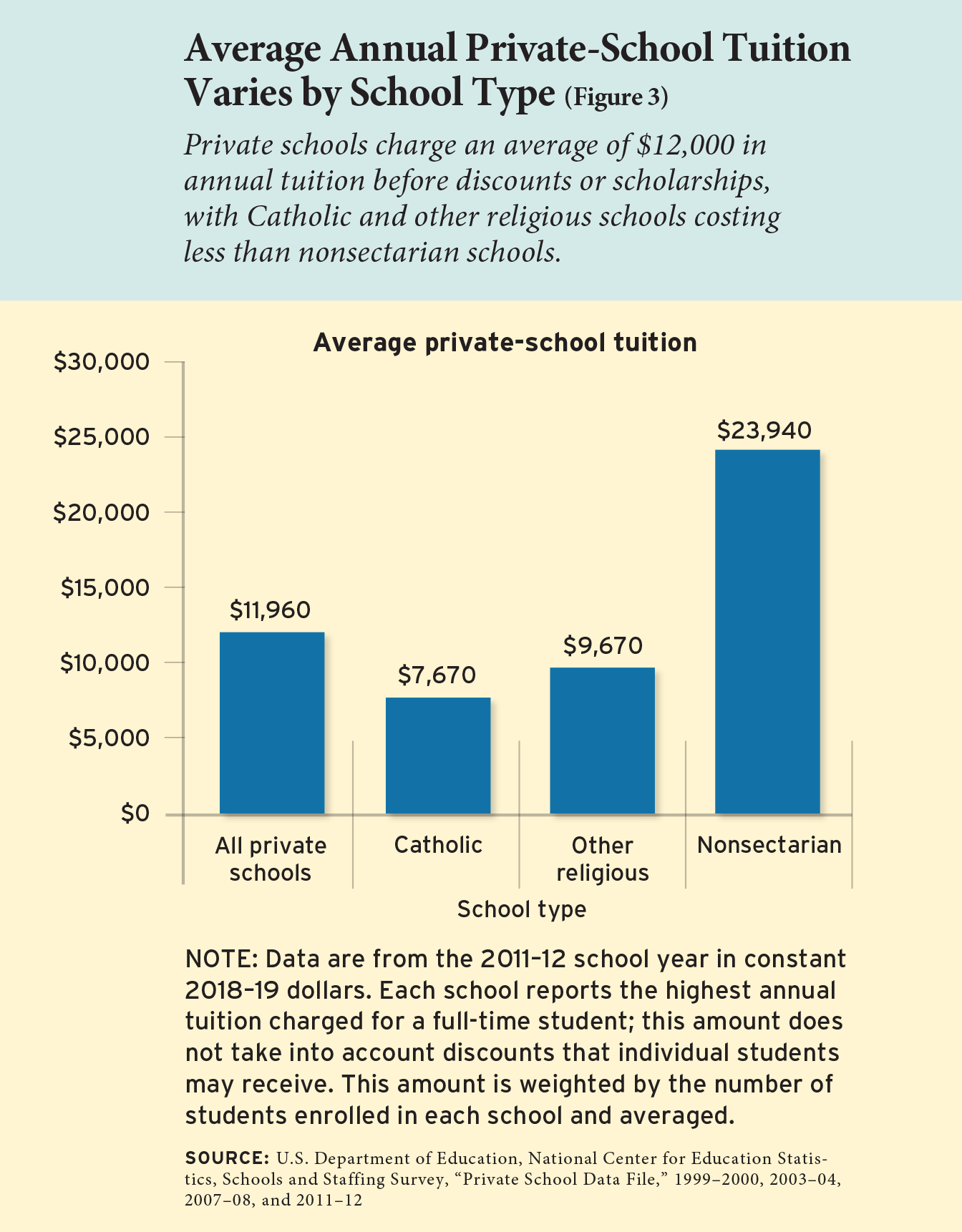
The Institute of Notre Dame, a 170-year-old Catholic girls’ school in Baltimore whose graduates included Speaker of the House Nancy Pelosi and Senator Barbara Mikulski, announced in May that it would close.
“Sad news,” Pelosi tweeted. Mikulski called it a “treasured institution.”
The Covid-19 pandemic has accelerated the number of urban Catholic and other private schools that are closing amid financial pressure and dwindling enrollment. Contrary to popular understanding, many private school students are from middle- and low-income families, and many private schools are expressly dedicated to serving them (see Figure 1). As of July 9, a Cato Institute tracker listed 97 private schools that had announced permanent closures attributed at least partially to the pandemic.

Such closures are an important part of the story of how the pandemic has affected private schools. But the tale isn’t entirely one of weakness. Other schools have used their autonomy, flexibility, and strong family and community relationships to deliver robust distance learning.
The right policy choices now can help ensure that private schools remain viable alternatives for families, even as all schools enter a period of newly constrained resources.

Responding to the Crisis
As the landscape rapidly shifted this spring, the Center on Reinventing Public Education and the American Enterprise Institute were fast out of the gate with data collection and analysis. CRPE began publishing data on school-district response plans in mid-March. AEI began conducting longitudinal surveys of districts a week later. EdChoice, Echelon Insights, Education Week, Pew Research, and others have also tracked student, teacher, and parent perspectives and experiences.
Several of these efforts provide insight into private schools. Morning Consult and EdChoice surveyed teachers across private, charter, and district schools. Hanover Research and EdChoice surveyed private school employees across the country. The Association of Christian Schools International surveyed their members in the United States. More recently, the Education Next survey gathered data from parents across district, charter, and private schools, and the National Center for Research on Education Access and Choice published an analysis of 3,500 district, charter, and private school websites.
The data paint an incomplete picture of how private schools have fared in the crisis so far, but they do suggest considerable variation. In the Morning Consult/EdChoice survey, 48 percent of private school teachers indicated they were providing e-learning, 32 percent said they were providing at-home assignments, and 16 percent said they weren’t providing either. The Hanover Research/EdChoice survey (to which about 3 in 10 responses came from private schools in Florida) also shows variation among private schools. Overall, 88 percent of private school employees reported that their schools had shifted to online learning with formal curricula, including 92 percent of Catholic private schools and 65 percent of nonreligious private schools. Schools responding to the survey by the Association of Christian Schools International reported differences in distance learning, as well. A majority of schools reported providing three to five hours a day of distance learning, though high schools often provided more and elementary schools often provided less.
Anecdotal accounts confirm that private-school responses to the crisis run the gamut. On one end of the spectrum are schools that have been unable to sustain operations past the current school year. Numerous media accounts have noted private schools that have closed not only for the school year, but permanently. In addition to the Institute of Notre Dame in Baltimore, these include All Saints Catholic School in Wilmington, Delaware; four schools in the Archdiocese of Galveston-Houston; at least 10 schools in New Jersey; and 20 schools in the Archdiocese of New York, among others. The Archdiocese of Galveston-Houston described how the pandemic influenced its decision to close schools: “In recent weeks, the reality of our budget challenges, drastically and negatively compounded by the Covid-19 protocols, forced a reassessment of these schools’ viability. . . . These dire circumstances have forced our hand.”
On the other end of the spectrum are private schools that entered the pandemic in positions of relative strength. Partnership Schools, a network of nine Catholic schools in New York City and Cleveland serving predominantly low-income students, found itself at the epicenter of the outbreak. Superintendent Kathleen Porter-Magee recalls the week of March 9 as a sprint to anticipate and adapt to conditions that changed by the hour. The network’s response pivoted quickly from procuring supplies and sanitizing buildings on Monday to, by Wednesday, planning to close their buildings for the foreseeable future. “We had war room meetings every morning and sent email communications every afternoon,” Porter-Magee said, “and sometimes that still didn’t feel like it was fast enough.”
In a process that involved pivoting on a daily and hourly basis and ascertaining families’ needs for devices and Internet access, as well as a few all-nighters, Partnership Schools was able to send students home on March 13 with a week’s worth of pencil-and-paper material. The week after, the schools rolled out a remote-learning plan that they continued to iterate and tweak through the end of the school year.
The majority of private schools likely lie somewhere between these two extremes, muddling through as best they can during an unprecedented disruption. In the words of Frank O’Linn, superintendent of schools for the Diocese of Cleveland, “Like so many crises, it’s a test. It has revealed a lot of strong schools and some phenomenal stories . . . but not all are phenomenal.”

Transition to Remote Learning
What factors influence whether a school fails or flourishes under extreme duress? Common sense, as well as the literature on crisis management, suggests that a school’s ability to respond and adapt in the midst of a crisis likely depends on three broad
factors: autonomy and flexibility, family and community relationships, and financial resources.
Some have been quick to posit that private schools (and charter schools) have been nimblest in their response to the shutdown. There are some data consistent with this claim. On the 2020 Education Next survey, parents of nearly 70 percent of private school students said their children met virtually with their school or teachers and their classmates several times a week. Parents of only 43 percent of district students said the same. Private school students were also more likely to receive instruction that included new content, as opposed to all review material.
Other data complicate this narrative, however. The analysis from the National Center for Research on Education Access and Choice suggests that charter and district schools did more to support some aspects of learning, such as “personalization and engagement outside of class.” Ultimately, assessing the effectiveness of school responses will require further research not only on how schools responded but on how much students learned (or didn’t learn) as a result.
In the meantime, it’s useful to explore how the autonomy and flexibility of private schools may have affected their ability to respond effectively. Leaders of private schools typically have direct oversight and authority over not only curriculum and instruction, but also human resources, operations, and finances. Many non-Catholic Christian and nonsectarian schools operate independently from any larger system. Even Catholic schools, which operate under the purview of the Church, benefit from a strong adherence to “subsidiarity”—the principle that matters are best handled at the most decentralized level possible.
However, autonomy and flexibility can also leave the leaders of individual schools adrift and isolated when a crisis hits. Frankie Jones of the University of Notre Dame’s Alliance for Catholic Education Academies and Mary Ann Remick Leadership Program has seen “a lot of principals looking for help and guidance” and efforts from the Church to maintain school-leader autonomy while providing support. To help school-level leaders and staff, for instance, some dioceses have created virtual spaces to share ideas and challenges, trained teachers to use virtual-learning platforms, or provided guidance on how schools should prioritize family and student needs. Church policies impose relatively few regulatory burdens and governance structures on schools, thereby pushing decisions to the local level. But intentional efforts to inform, guide, and support local decisionmakers are necessary for this degree of flexibility to work.
When it comes to family and community relationships, private schools may also have a leg up. The religious orientation of many private schools often ties them to local churches or synagogues and includes theological principles that prioritize family engagement and service to the community. Family relationships are a central component of Catholic schools, for instance, because church doctrine establishes parents as children’s primary educators. Kathleen Porter-Magee describes Partnership Schools’ approach to the crisis: “We ramped up our academics, but we led first and foremost by connecting with families to figure out how they [were doing]. . . . That community-first approach is actually what paved the way for keeping learning going.”
Private schools also have an incentive to build strong relationships with families and the community because much of their revenue depends on families choosing to enroll their children and to contribute even modest sums to tuition. Mary Menacho, the interim executive director of the California Association of Independent Schools, said that the 2008 recession helped prepare private schools for today’s crisis. Since 2008, she said, “independent schools have had to look at what their value-add is, hone their mission, and clarify what sets them apart. That has been the basis for strong relationships with their families—clarity on what schools are offering and what makes them distinct.” It stands to reason that private schools that have invested in building relationships and communicating their distinct value proposition to families are positioned to partner with families to support students learning from home.
While private schools may well benefit from autonomy, flexibility, and strong family and community relationships, however, they mostly lack access to taxpayer funds and often operate on shoestring budgets. Even the nimblest schools with the strongest family and community relationships can find themselves on the ropes if they do not have cash on hand to purchase cleaning supplies, buy and distribute devices, print learning materials, or procure virtual-learning platforms. An effective response requires money, and many private schools—especially those dedicated to serving middle- and low-income families—were already on shaky financial footing leading into the coronavirus crisis.
In the Hanover/EdChoice survey, about 4 in 10 private-school respondents were “extremely or very worried” about collecting tuition for the remainder of the school year or about drops in philanthropic support, and roughly half were “extremely or very worried” about losing enrollment (see Figure 2). For some private schools, the financial effects have already begun. The survey conducted by the Association of Christian Schools International indicates that about one in five of their member schools has provided tuition discounts or refunds, and more than a quarter have furloughed staff. About one-third of schools have re-enrollment rates lower than those at the same time last year, and more than half report a decline in new student inquiries—an ill omen for the fall.

All told, the financial outlook for private schools is shaping up as a severe challenge. Economic turmoil may make even modest contributions to school tuition untenable for many middle- and low-income families (see Figure 3). Schools that rely on subsidies from churches receive less support when weekly in-person church services are canceled and offerings decline. Companies facing losses may cut corporate donations to tax-credit scholarship programs. Foundation assets are bound to take a hit, as well, with implications for philanthropic support for schools and scholarships. Finally, as states resize their budgets, it’s likely that funding for education will be cut—with potential implications for voucher programs and state education savings accounts.

Superintendent O’Linn of Cleveland put a fine point on the problem: “When you’ve got a system highly dependent on good will and philanthropy, and you have not just the medical crisis but also the economic crisis. . . . We’re very concerned about it.” Many predict the challenge will be greatest for schools that are already small or underenrolled. Laura Colangelo of the Texas Private Schools Association said she sees underenrolled Catholic schools and small Christian schools as the most vulnerable. But, she said, “independent schools and even more elite private schools are very cautious, as well.”
As the economic picture for the country worsens, the challenges of financial viability could easily outweigh the benefits of autonomy and family relationships. These issues are connected. Said O’Linn, “We need the government to help with the funding. But if we don’t provide the value proposition and the family atmosphere, families won’t choose us.”
Government Support
For all the uncertainty wrought by the crisis, it’s clear that many private schools serving middle- and low-income students will need financial support to survive. Financial support that maximizes autonomy and flexibility and leverages schools’ family and community relationships is even better.
The federal government has already taken steps to support private schools and students through the crisis. First and foremost, private schools can benefit from several aspects of the Coronavirus Aid, Relief, and Economic Security, or CARES, Act, including the $660 billion Small Business Administration Paycheck Protection Program. As of late April, many private schools—including 72 percent of schools that responded to the survey conducted by the Association of Christian Schools International—were planning to participate. It’s unclear how many private schools have actually accessed Small Business Administration loans. Some private schools were reluctant to participate because of concern that accepting federal aid would require them to demonstrate compliance with a host of federal regulations.
Private schools may also get relief from the CARES Act’s $31 billion Education Stabilization Fund, which includes $3 billion for the Governor’s Emergency Education Relief Fund and $13.5 billion for the Elementary and Secondary School Emergency Relief Fund. Under both programs, districts can receive funding to provide support to schools, including mental health services, technology, or cleaning supplies. Private schools can access these supports from the local school district but do not receive any funding themselves.
The distribution of money from the Governor’s Emergency Education Relief Fund depends on the priorities of governors, but states have less discretion over the distribution of money from the Elementary and Secondary School Emergency Relief Fund. On June 25, U.S. Secretary of Education Betsy DeVos issued a binding rule for how school districts must share this funding with non-public schools. The rule gives districts two options. The first bases private-school support on the total number of all private school students living in a district, rather than the number of low-income private school students. That approach contrasts with the way districts typically provide federally funded services to private schools, based on a Title I formula directing money to low-income students. This first option in the DeVos rule would end up directing much more aid to private schools, but districts have another choice: they can share the money based on the number of low-income students in private schools, but only if the district in turn directs its portion of the funding exclusively to low-income students. This second option, however, would limit districts’ flexibility in using the money. Several state attorneys general, led by California’s, have sued over the new rule.
Neither of these two funding programs is particularly well designed to fit the specific strengths and challenges of private schools. First, while school districts are required to consult with private schools, private schools have little control over how the Elementary and Secondary School Emergency Relief Fund money is used. This approach does not take advantage of private schools’ autonomy and flexibility. Second, the rule on the distribution of funds to private schools may provide disproportionate aid to private schools, but it does not target aid to the private schools most in need of that aid—those serving middle- and low-income families. In future relief legislation, federal policymakers can do more to ensure that funding is directed to high-need student populations, while also allowing the maximum flexibility for school-level leaders.
Alongside federal efforts to stabilize the education system, state policymakers also have an essential role. Financial support for schools will likely be an issue of significant debate in the next round of state budget negotiations. State policymakers will surely work to preserve as much funding as possible for public schools, but they should also consider the needs of middle- and low-income families enrolled in private-school choice programs.
Vouchers, tax-credit scholarship programs, and state education savings accounts are products of state law. Seventy percent of students who participate are in means-tested school-choice programs, available only to those with household incomes below a certain threshold. Many more participating students are in programs that are only accessible to students with special needs or circumstances, such as learners with exceptionalities or in foster care. State policymakers eager to direct support to middle- and low-income families can start by preserving funding for these programs.
In doing so, they will also help preserve institutions that, if lost, would send students flooding back to the public system—just as that system itself is navigating ongoing disruption and uncertainty. Following the Great Recession, student enrollment in private schools dropped by as much as 40 percent in the hardest-hit metropolitan areas. If even 10 percent of private school students returned to the public system, states’ education-funding liabilities would increase by $3.3 billion, EdChoice estimates. In the midst of an economic crisis, policymakers should resist efforts to scale back programs that generally produce higher levels of student proficiency, stronger educational attainment, and positive competitive effect on other schools in their vicinity—especially when they achieve those results with much less per-pupil public funding.
Policymakers might even be wise to consider raising funding caps on private-school choice programs to accommodate increased demand. Owing to declining household incomes, a growing number of families will be eligible to participate in these programs. Demand for private schools may also increase because parents have varying perspectives on how and when students should return to school. A USA Today/Ipsos poll in late May found that less than half of parents support students returning to school in the fall in the absence of a vaccine. Meanwhile, 58 percent of parents indicated they would support a hybrid in-person and distance-learning approach, and 59 percent said they would consider at-home learning options like online education or home schooling. A poll by the National Parents Union/Echelon Insights found that parents also differ on how schools should help students make up for lost learning time: 53 percent of parents support extending the school day, while 63 percent support extending the school year. Increasing access to private-school choice would allow middle- and low-income parents more options in selecting a school whose approach to reopening aligns with their own preferences.
Looking Ahead
In the coming months and years, schools across all sectors will need to assess and address learning gaps, support social-emotional needs, and protect public health. If state funding indeed declines and private-school enrollment drops, public schools will likely need to provide more services to more students with fewer resources. Public education systems will probably struggle to maintain student outcomes under these circumstances, and many students will backslide.
The long-term consequences of this decline are not hard to predict. As public schools struggle to meet student needs, dissatisfied families will look for alternatives. If more private schools serving middle- and low-income students close, those alternatives will narrow. And, if funding for private-school choice programs is cut, access to those alternatives will once again be limited by families’ financial means. Unless policymakers consider the needs of private schools alongside those of public schools, the sector could lose enormous ground in providing families with equitable access to choice.
To be sure, resources are finite, and the diversity and depth of needs are profound. But while protecting private-school choice will certainly force tough choices for policymakers today, it will preserve better choices for students and families in the future.
Juliet Squire is a partner on the policy and evaluation team at Bellwether Education Partners, where she concentrates on issues related to charter schools, private-school choice, and rural education. ACE Academies, EdChoice, and Partnership Schools have been clients of Bellwether Education Partners.
Read more from Education Next on coronavirus and Covid-19.
The post In Pandemic, Private Schools Face Peril appeared first on Education Next.